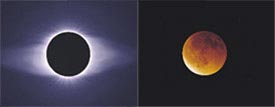
Above, left: Total eclipse of the Sun, October 24, 1995. Photograph © 1996 Wendy Carlos and Fred Espenak. Above, right: Total eclipse of the Moon, April 3&150;4, 1996. Photograph by Patrick Martinez.
Eclipses come in two flavors: solar and lunar. Solar eclipses occur when part (or all) of the Moon blocks the Sun and the Moon's shadow falls upon the Earth. During a total solar eclipse, nearly half the globe can see at least part of the Sun blocked by the Moon. But for those lucky enough to live or travel to the path of totality, they are in for a treat unlike any other. Whether it's the black disk of the Moon set against the ghostly, pearly white corona, the solar prominences gleaming like pink rubies along the lunar limb, or the spectacular diamond-ring effect bursting forth, the image of an eclipse remains forever etched in a viewer's mind.
A lunar eclipse occurs when the Earth lies between the Sun and the Moon, so that Earth’s shadow darkens the Moon. This can only happen when the Moon is full. The dark, central shadow is called the umbra, while the lighter shadow that surrounds it is the penumbra. The penumbral shadow is weak and often difficult to detect; for most observers a lunar eclipse really gets going when the umbra first touches the lunar surface. Totality occurs when the Moon is completely immersed in the Earth’s umbral shadow.
Lunar eclipses, which are enjoyed by half the Earth at a time, get their colorful red-orange hues as sunlight filters through Earth's atmosphere. This is the light of all the world's sunrises and sunsets ringing the globe.
Here is a brief description of this year's eclipses of the Sun and Moon. More details will appear on this website and in Sky & Telescope magazine as the date of each draws near. Times are in Universal Time (UT or GMT) except as noted. All the non-S&T diagrams found via the links are courtesy Fred Espenak.
Total Lunar Eclipse: March 3, 2007
If you live in eastern North America, when the Moon rises at sunset on March 3rd a total lunar eclipse will already be under way (or just about to begin). Total eclipse runs from 22:44 to 23:58 UT (5:44 to 6:58 p.m. Eastern Standard Time). Compare these times with your local times of sunset and moonrise, which are available by putting your location into our online almanac.
As this map shows, the whole eclipse will be visible from start to finish late at night from Europe and Africa. It happens before and during dawn on March 4th local date for Asia and Australia.
Partial Solar Eclipse: March 19, 2007
The first solar eclipse of the year comes two weeks — a half a Moon orbit — after the lunar eclipse. It can be seen from westernmost Alaska and much of Asia, weather permitting. For those placed just right, maximum eclipse will be around 87% at 2:32 UT.
Total Lunar Eclipse: August 28, 2007
The second lunar eclipse of 2007 will be a dandy for observers in central and western North America before and during dawn on this date. Totality runs from 9:52 to 11:22 UT (2:52 a.m. to 4:22 a.m. Pacific Daylight Time). Again, compare these times with your local times of moonset and sunrise.
Observers near the West Coast will see the event in full, including all of the partial phases and the 90 minutes of totality. For the eastern US and Canada and much of South America, the show will be cut short as the Moon sets and the Sun rises.
Partial Solar Eclipse: September 11, 2007
The last eclipse of the year will be visible only from Antarctica and parts of South America. Greatest eclipse (75% of the way to total) occurs in the South Ocean at 12:31 UT. Early risers in much of southern South America will see the Sun partially blocked during and/or soon after sunrise.
The next total eclipse of the Sun will cross parts of northern Asia on August 1, 2008.
It's been a while since North America experienced a total solar eclipse of the Sun, and don't hold your breath; the next crossing populated areas will come on August 21, 2017.
Here's a map showing future total solar eclipse paths over Canada, Mexico, and the United States through 2050.
 0
0
Comments
You must be logged in to post a comment.